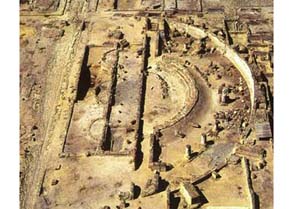ASTRONOMY AND ITS LIMITS: FROM THE MYTH TO
HELIOCENTRISM
The first hypothesis
about the structure and the origin of the universe are to be found in
mythology: in fact the relationship between astronomy and religion, that will
last for ages, is justified by the mystery that the universe represented for
the primitive men. The sky was considered the reign of the supernatural
and divine because it was not
accessible. So, the first civilizations tried to establish links among the
heavenly phenomena and the human ones in order to explain some of the
mysterious events that surrounded them.
 The first
astronomers were the Sumerian and Babylonian priests that 5000 years ago
observed the movements of the Sun, the Moon and the planets and their
differences with the stars. They found out that the eclipses repeat
periodically but they could not make their own cosmological model. Also the Egyptians were interested in astronomy
and they formulated a solar calendar, dividing the day in 24 hours and the
hours in 60 minutes, but they produced
only myths without real basis.
The first
astronomers were the Sumerian and Babylonian priests that 5000 years ago
observed the movements of the Sun, the Moon and the planets and their
differences with the stars. They found out that the eclipses repeat
periodically but they could not make their own cosmological model. Also the Egyptians were interested in astronomy
and they formulated a solar calendar, dividing the day in 24 hours and the
hours in 60 minutes, but they produced
only myths without real basis.
The Greeks have been
great astronomers because they improved both the instruments to observe the
Universe and their mathematical knowledge. They elaborated few hypotheses about
the origin and the structure of the Universe but since the VIIth century B.C.
they created and believed in a perfect and ordinate system in which the Earth
was the centre and the dominant part. At that time, the Greeks still thought
that the Earth was a plate disk and that the Sun had the dimension of the
Peloponnesus. Pythagoras and his school
in the Vth century B.C. found out that the Earth is spherical but they also
believed that the Universe was formed by ten (perfect number) celestial bodies:
the Earth, the Moon, the Sun, the five planets already known ( Mercury, Venus,
Jupiter, Mars and Saturn) , the fixed stars and they added an invisible planet
called Anti-Earth to obtain 10 as a result. However, a real model was created
and theorised only a few centuries after, in the IInd century A.D. by Claudius
Ptolemy; it was described in his work "Almagesto". This was the geocentric
model.




 The first
astronomers were the Sumerian and Babylonian priests that 5000 years ago
observed the movements of the Sun, the Moon and the planets and their
differences with the stars. They found out that the eclipses repeat
periodically but they could not make their own cosmological model. Also the Egyptians were interested in astronomy
and they formulated a solar calendar, dividing the day in 24 hours and the
hours in 60 minutes, but they produced
only myths without real basis.
The first
astronomers were the Sumerian and Babylonian priests that 5000 years ago
observed the movements of the Sun, the Moon and the planets and their
differences with the stars. They found out that the eclipses repeat
periodically but they could not make their own cosmological model. Also the Egyptians were interested in astronomy
and they formulated a solar calendar, dividing the day in 24 hours and the
hours in 60 minutes, but they produced
only myths without real basis. 


